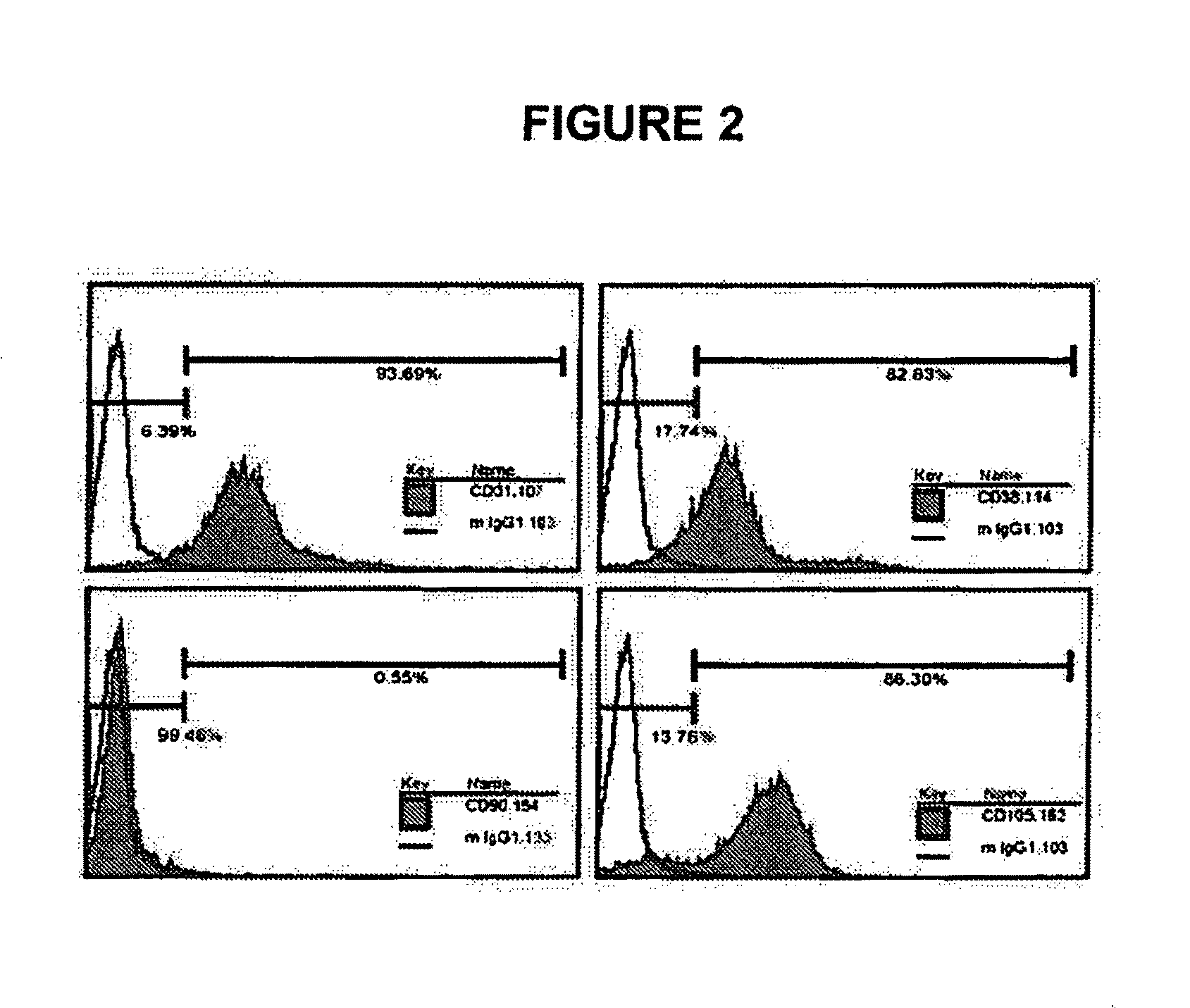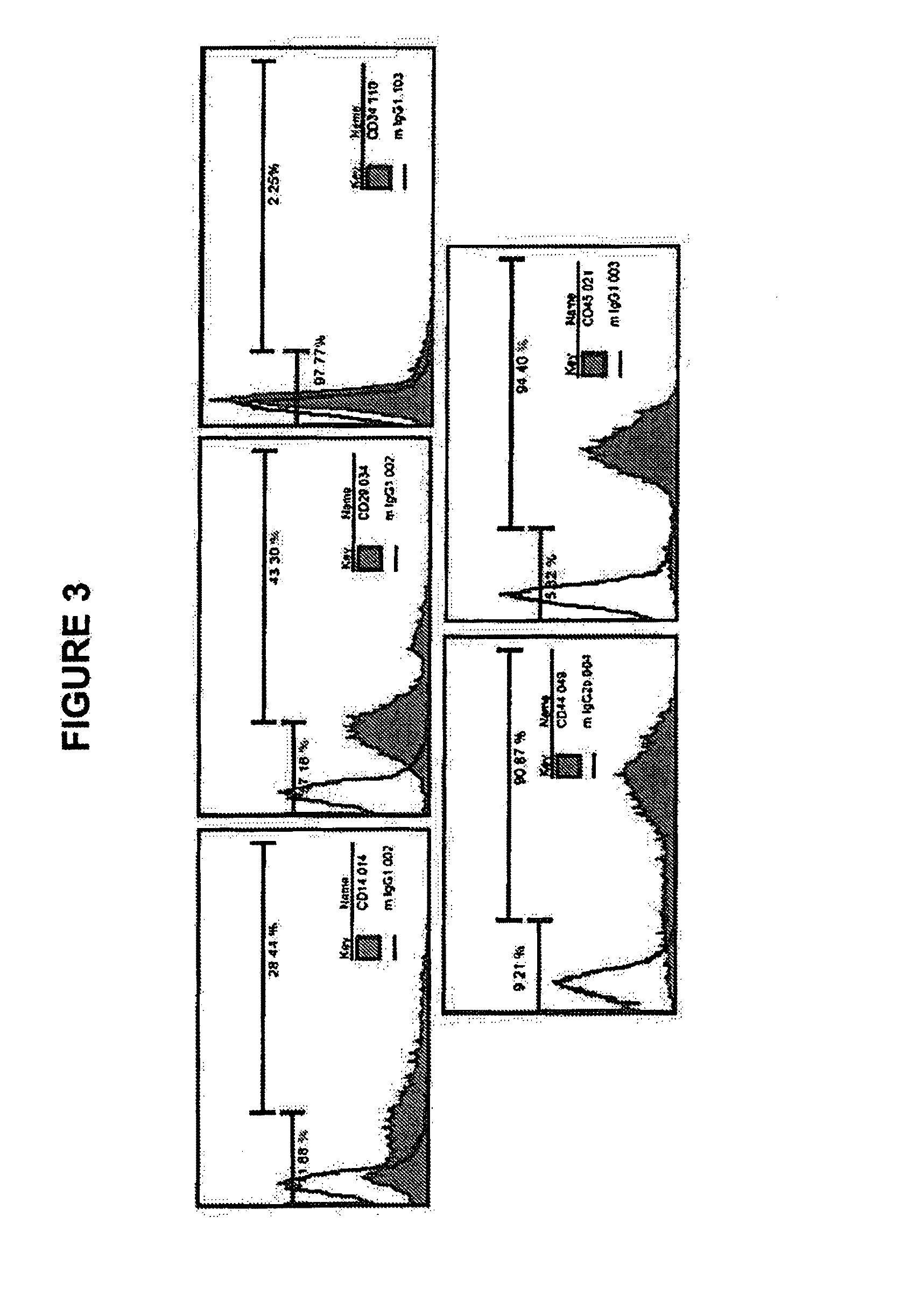Method of generating multilineage potential cells
- Summary
- Abstract
- Description
- Claims
- Application Information
AI Technical Summary
Benefits of technology
Problems solved by technology
Method used
Image
Examples
example 1
Production of MLPC
[0189]Standard techniques were used to extract venous blood from healthy human adults and separate peripheral blood mononuclear cells (PBMC) using density gradient centrifugation.
[0190]A sample of CD14+ PBMC was placed in a FEP blood bag. A volume of 6% human serum albumin solution equal to the CD14+ PBMC sample was added.
[0191]A cell culture medium suitable for stem cell culture was added. The final mixture was approximately be constituted of 15% of CD14+ PBMC, 15% of 6% human serum albumin solution and 70% of cell culture medium.
[0192]An optional volume of 10 mg / L insulin can be added to promote cell growth.
[0193]The cell culture was then incubated in a 5% CO2 incubator at 37° C. for 90 minutes for PBMC to adhere to inside of the bag. After adhesion, the cells were incubated for 1 to 7 days where MLPC will be derived throughout this period. On day 7, the cell culture was removed from the bag wall and washed with 0.9% sterile normal saline. The resultant MLPC were...
example 2
Characterization of the MLPC
1. Morphological Observation of MLPC
[0194]Slides were prepared with samples of the cell culture from 1 day, 2 day, 3 day, 4 day, 5 day, 6 day and 7 day post-incubation in a CO2 incubator at 37° C. To study MLPC's biological characteristics, adherent cells phenotypes were analysed by an inverted microscope during cell cultivation periods (FIGS. 1 to 8.)
2. Flow Cytometry Analysis
[0195]To identify MLPC stem cell expression, surface markers were analyzed by flow cytometry. MLPCs were harvested and washed with PBS from a closed bag system, centrifuged at 1500 rpm at 4° C. for 5 minutes, and the cell pellet kept. The cell density was adjusted to 1×106 cells per tube, cells re-suspended in 100 microliters PBS buffer and transferred to a 1.5 mL vial. MLPCs were incubated with 5-20 μl Fluorochrome-labeled antibodies including CD14-FITC, CD29-PE, C31-PE, CD34-PE, IgG-PE isotype control (MACS, Germany), CD38-PE, CD45-PE, CD90-FITC, CD105-PE, (BD PharMingen, CA) at 4...
example 3
Protein expression of CD14+ Multi-Lineage Potential Cells
Protein Expression by 2DE and MALDI-TOF / MS / MS Analysis
Preparation of Cells Extract
[0201]Cellular proteins were collected from CD14-positive of PBMCs-pool of 4 health's volunteer after 4-7 days cultivation. Briefly, protein extraction of cells was obtained by urea lysis buffer and acetone purification.
[0202]Samples from each group were mixed equally according to the protein quantity and 2-DE was then performed using IPG strips (18 cm, pH 3-11, linear (L); GE Healthcare, Amersham, USA) and 12.5% sodium dodecyl sulfate polyacrylamide gel electrophoresis (SDS-PAGE) in duplicate 3 times using the IPGphor IEF system and Ettan DALTSix System (Amersham Biosciences, USA).
[0203]The gels were stained with CyproRuby (GIBCO) and scanned with an image scanner (Amersham Biosciences, USA) for protein spots identification. Proteins were obtained by in-gel digestion; gel spots were de-stained in 50% acetonitrile (ACN) and 25% 50 mM NH4HCO3, the...
PUM
 Login to View More
Login to View More Abstract
Description
Claims
Application Information
 Login to View More
Login to View More - R&D
- Intellectual Property
- Life Sciences
- Materials
- Tech Scout
- Unparalleled Data Quality
- Higher Quality Content
- 60% Fewer Hallucinations
Browse by: Latest US Patents, China's latest patents, Technical Efficacy Thesaurus, Application Domain, Technology Topic, Popular Technical Reports.
© 2025 PatSnap. All rights reserved.Legal|Privacy policy|Modern Slavery Act Transparency Statement|Sitemap|About US| Contact US: help@patsnap.com



